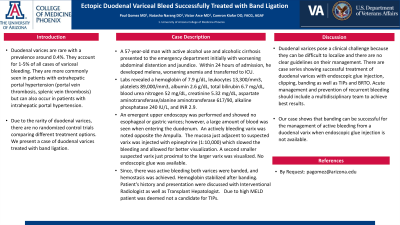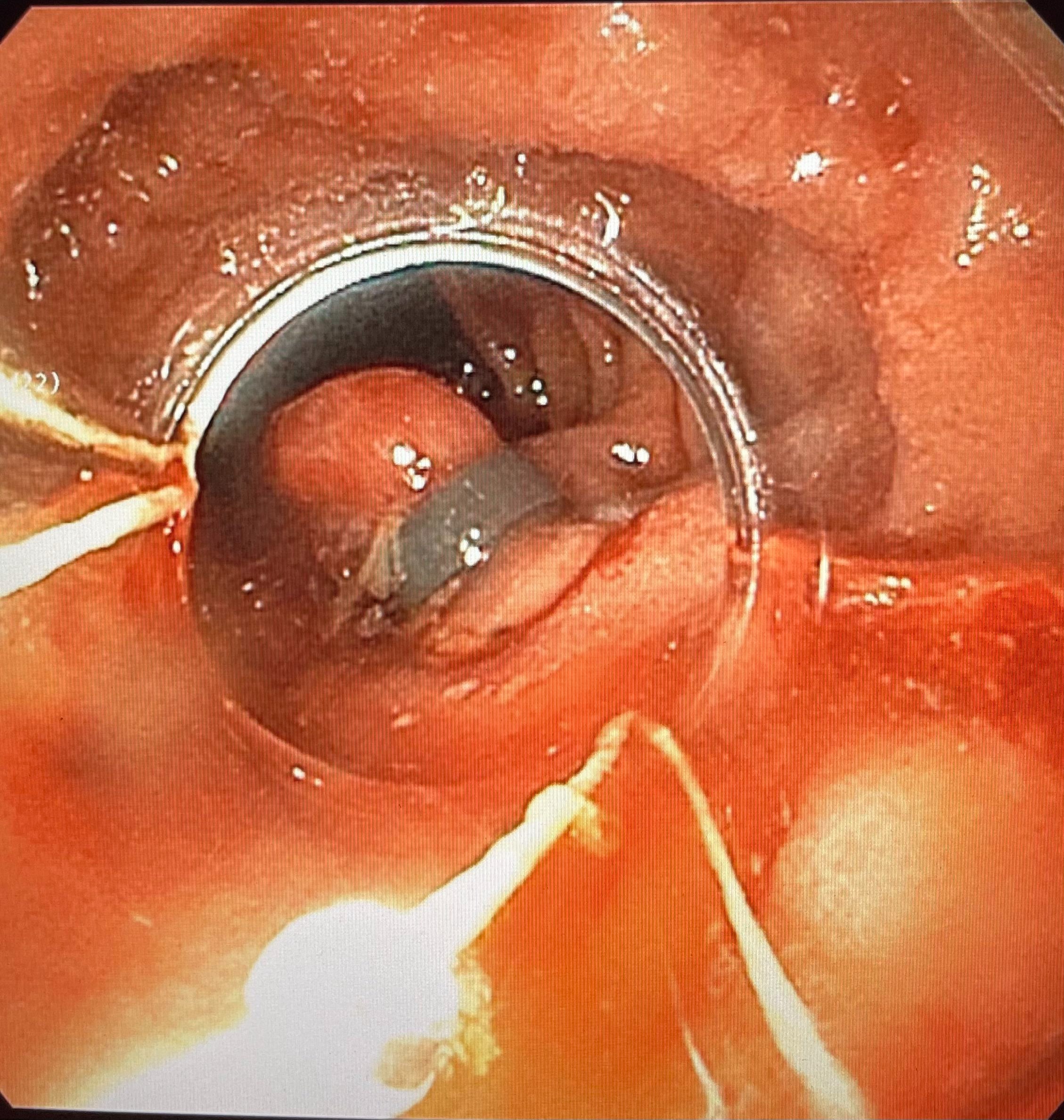Tuesday Poster Session
Category: GI Bleeding
P3527 - Ectopic Duodenal Variceal Bleed Successfully Treated With Band Ligation
Tuesday, October 24, 2023
10:30 AM - 4:00 PM PT
Location: Exhibit Hall

Has Audio
- PG
Paul Gomez, MD
University of Arizona College of Medicine
Phoenix, Arizona
Presenting Author(s)
Paul Gomez, MD1, Natasha Narang, DO1, Victor Arce Gutierrez, MD1, Camron Kiafar, DO, FACG2
1University of Arizona College of Medicine, Phoenix, AZ; 2Phoenix VA Medical Center, Phoenix, AZ
Introduction: Duodenal varices are rare with a prevalence around 0.4%. They account for 1-5% of all cases of variceal bleeding. They are more commonly seen in patients with extrahepatic portal hypertension (portal vein thrombosis, splenic vein thrombosis) but can also occur in patients with intrahepatic portal hypertension. Due to the rarity of duodenal varices, there are no randomized control trials comparing different treatment options. We present a case of duodenal varices treated with band ligation.
Case Description/Methods: A 57-year-old man with active alcohol use and alcoholic cirrhosis presented to the emergency department initially with worsening abdominal distention and juandice. Within 24 hours of admission he developed melena, worsening anemia and transferred to ICU. Labs revealed a hemoglobin of 7.9 g/dL, leukocytes 13,300/mm3, platelets 89,000/mm3, albumin 2.6 g/dL, total bilirubin 6.7 mg/dL, blood urea nitrogen 52 mg/dL, creatinine 5.32 mg/dL, aspartate aminotransferase/alanine aminotransferase 617/90, alkaline phosphatase 240 IU/L, and INR 2.9. An emergent upper endoscopy was performed and showed no esophageal or gastric varices, however a large amount of blood was seen when entering the duodenum. An actively bleeding varix was noted opposite the Ampulla. The mucosa just adjacent to suspected varix was injected with epinephrine (1:10,000) which slowed the bleeding and allowed for better visualization. A second smaller suspected varix just proximal to the larger varix was visualized. No endoscopic glue was available. Since, there was active bleeding both varices were banded and hemostasis was achieved. Hemoglobin stabilized after banding. Patient’s history and presentation were discussed with Interventional Radiologist as well as Transplant Hepatologist. Due to high MELD patient was deemed not a candidate for TIPs.
Discussion: Duodenal varices pose a clinical challenge because they can be difficult to localize and there are no clear guidelines on their management. There are case series showing successful treatment of duodenal varices with endoscopic glue injection, clipping, banding as well as TIPs and BRTO. Acute management and prevention of recurrent bleeding should include a multidisciplinary team to achieve best results. Our case shows that banding can be successful for the management of active bleeding from a duodenal varix when endoscopic glue injection is not available.

Disclosures:
Paul Gomez, MD1, Natasha Narang, DO1, Victor Arce Gutierrez, MD1, Camron Kiafar, DO, FACG2. P3527 - Ectopic Duodenal Variceal Bleed Successfully Treated With Band Ligation, ACG 2023 Annual Scientific Meeting Abstracts. Vancouver, BC, Canada: American College of Gastroenterology.
1University of Arizona College of Medicine, Phoenix, AZ; 2Phoenix VA Medical Center, Phoenix, AZ
Introduction: Duodenal varices are rare with a prevalence around 0.4%. They account for 1-5% of all cases of variceal bleeding. They are more commonly seen in patients with extrahepatic portal hypertension (portal vein thrombosis, splenic vein thrombosis) but can also occur in patients with intrahepatic portal hypertension. Due to the rarity of duodenal varices, there are no randomized control trials comparing different treatment options. We present a case of duodenal varices treated with band ligation.
Case Description/Methods: A 57-year-old man with active alcohol use and alcoholic cirrhosis presented to the emergency department initially with worsening abdominal distention and juandice. Within 24 hours of admission he developed melena, worsening anemia and transferred to ICU. Labs revealed a hemoglobin of 7.9 g/dL, leukocytes 13,300/mm3, platelets 89,000/mm3, albumin 2.6 g/dL, total bilirubin 6.7 mg/dL, blood urea nitrogen 52 mg/dL, creatinine 5.32 mg/dL, aspartate aminotransferase/alanine aminotransferase 617/90, alkaline phosphatase 240 IU/L, and INR 2.9. An emergent upper endoscopy was performed and showed no esophageal or gastric varices, however a large amount of blood was seen when entering the duodenum. An actively bleeding varix was noted opposite the Ampulla. The mucosa just adjacent to suspected varix was injected with epinephrine (1:10,000) which slowed the bleeding and allowed for better visualization. A second smaller suspected varix just proximal to the larger varix was visualized. No endoscopic glue was available. Since, there was active bleeding both varices were banded and hemostasis was achieved. Hemoglobin stabilized after banding. Patient’s history and presentation were discussed with Interventional Radiologist as well as Transplant Hepatologist. Due to high MELD patient was deemed not a candidate for TIPs.
Discussion: Duodenal varices pose a clinical challenge because they can be difficult to localize and there are no clear guidelines on their management. There are case series showing successful treatment of duodenal varices with endoscopic glue injection, clipping, banding as well as TIPs and BRTO. Acute management and prevention of recurrent bleeding should include a multidisciplinary team to achieve best results. Our case shows that banding can be successful for the management of active bleeding from a duodenal varix when endoscopic glue injection is not available.

Figure: Endoscopic Band Ligation of Bleeding Duodenal Varix
Disclosures:
Paul Gomez indicated no relevant financial relationships.
Natasha Narang indicated no relevant financial relationships.
Victor Arce Gutierrez indicated no relevant financial relationships.
Camron Kiafar indicated no relevant financial relationships.
Paul Gomez, MD1, Natasha Narang, DO1, Victor Arce Gutierrez, MD1, Camron Kiafar, DO, FACG2. P3527 - Ectopic Duodenal Variceal Bleed Successfully Treated With Band Ligation, ACG 2023 Annual Scientific Meeting Abstracts. Vancouver, BC, Canada: American College of Gastroenterology.
